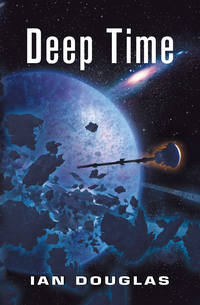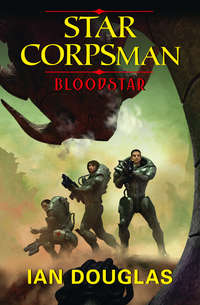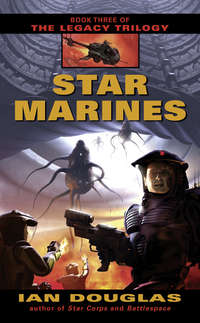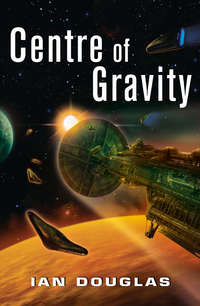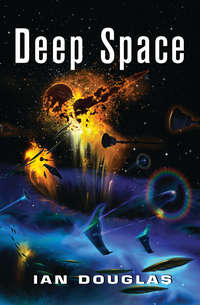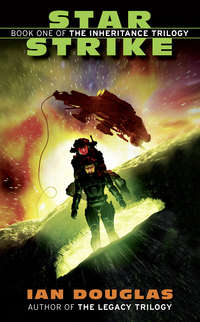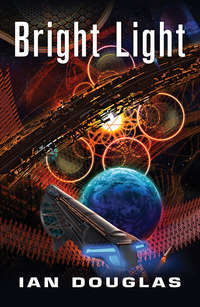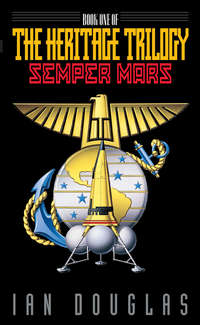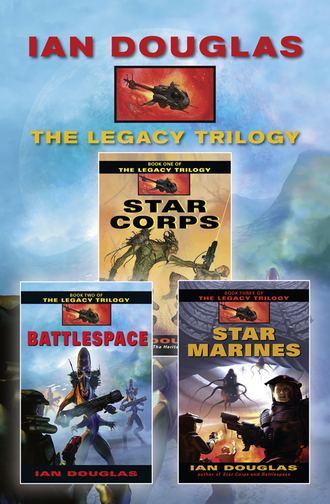
Полная версия
The Complete Legacy Trilogy: Star Corps, Battlespace, Star Marines
“So they can throw the equivalent of a thermonuke at targets in orbit,” Ramsey said, “or split off a tactical nuke’s worth for close-in point defense. Slick.”
“But that kind of mass acceleration would require incredible energy,” General King protested. “Where are they getting their power? Damn it, the Frogs are supposed to be primitives!”
Ramsey wished that King would get off that particular soapbox. The An were what they were, and complaining about their abilities—or their technological inconsistencies—was not going to help.
“Analyses of the subsurface structures beneath the mountain suggest deep thermal sources,” Cassius replied. Within their minds, the command center AI unfolded a schematic of the tunnels and shafts inside and beneath An-Kur Mountain, as suggested by Emissary gravitometric scans and orbital reconnaissance. A pair of shafts, slender on the computer noumenal display but probably each measuring several tens of meters across, plunged from the extinct volcano’s throat deep, deep into Ishtar’s crust.
“An energy pump facilitating heat exchange with the planet’s deep crust via those twin vertical shafts would be essentially self-contained and self-sufficient,” Cassius continued. “Such a system could have been put in place thousands of years ago and remained functional without refueling or other technical intervention from outside, especially if the ancient An possessed sophisticated robotic systems for maintenance and repair.”
“Which also means they don’t have an antimatter production facility down there,” Ramsey pointed out. “That’s one piece of good news, at least.” A serious concern of the mission planning staff had been that the Ahannu might be able to spit chunks of antimatter at the approaching Earth transports. Not that blobs of plasma accelerated to near-c velocities were all that much better from the target’s point of view …
“What kind of range does a thing like that have?” Admiral Hartman demanded.
“Unknown, and I am unable to extrapolate from the given data,” Cassius said. “We know only that the Emissary was destroyed by a single shot while in orbit around Ishtar, at an altitude of approximately 312 kilometers.”
“Krakatoa is still over the horizon from us,” Ricia put in. “We won’t have line-of-sight for another … four hours, twelve minutes.”
“Then they have that long to take that thing out,” King said, his voice grim. “And God help us all if they fail!”
“They won’t fail,” Ramsey said. “Failure is not in the Marine lexicon.”
“A brave sentiment, Colonel,” King said. “I just wish I could be as certain of it as you. Admiral Hartman? Perhaps you’d best pass the word to have Regulus and Algol extend their range from us and from one another. We don’t want to be caught bunched together up here like shooting range targets.”
“It’s our men and women on the ground right now that I’m worried about,” Ramsey said. “If Krakatoa can divert some of the energy from a shot aimed straight up to cook targets nearby, what’s to stop the An from frying the ARLT?”
“Maybe they can’t shoot at their own slope,” Ricia said. “That would be, I don’t know, like shooting themselves in the foot? It might have a minimum range as well as a maximum. Threats any closer would be dealt with some other way.”
“Right,” Ramsey said. “I’ll buy that. So now the question is, what other defenses does Krakatoa have?”
“I imagine our people will be finding out pretty soon now,” Ricia said. “And Goddess help them when they do.”
ARLT Section Dragon Three
Objective Krakatoa, Ishtar
1642 hours ST
“C’mon, son!” Valdez said gently but firmly. Stooping, she slapped the back of his armored shoulder, urging him up and forward. “You can’t help him now!”
Garroway had dropped Pressley’s severed arm moments before, but he continued to lie in a shallow depression in the rock a meter away from the Marine’s blood-drenched lower torso. Pressley’s helmet lay nearby, the man’s black-irised eyes and gaping mouth clearly visible behind the blood-smeared visor.
“Garroway!” Valdez rasped. “Snap to, Marine!”
“A-Aye aye,” he managed to say.
“Hit your backbone,” she told him. “Do it!”
Backbone was Corps slang for the nanoneurotransmitters within his implanted technics that adjusted certain key chemical, muscular, and mental responses. They didn’t exactly banish fear at a thought-click, but they could help a Marine on the verge of going into shock to pull out of it, to focus on the task at hand, to keep from getting sick or simply having his legs fail beneath him.
Garroway nodded inside his helmet and focused on the mental code that activated the appropriate NNTs. He felt an inner rush, a kind of emotional flutter in his gut, and then he drew a sharp, deep breath. He could still feel the horror of Pressley’s death, but it was cocooned somehow, more distant, less immediate. He felt the strength coming back into his legs and belly, felt the shaking stop. “Thanks, Gunny,” he told Valdez.
“Keep moving, Marine,” she told him. “We have a mountain to take.”
She moved off without looking back. He picked up his weapon and followed.
ARLT Command Section, Dragon
One
Objective Krakatoa, Ishtar
1642 hours ST
Captain Warhurst remained harnessed inside Lander One, though he was almost completely unaware of his surroundings. As CO of the ARLT, he was expected to stay safe and give orders, coordinating the attack from the presumed security of the armored LM. The training invested in modern military officers was simply too expensive, too valuable, to allow them to lead from the front; indeed, they’d not done so for two centuries or more.
Warhurst listened to the rattle of small arms fire off the lander module’s hull and wondered who they were kidding with that kind of blatant rationalization. The LM was a definite target—a large and quite attractive one, in fact—while individual Marines wearing stealthy armor were able to literally fade into their surroundings and become very hard to hit.
And that too, he realized, was his own form of rationalizing things. The fact was, he wanted to be out there with his people right now, not stuck behind in this glorified tin can, watching an AI run the data link switchboard and holding the collective hands of the command staff still on planetary approach.
His noumenal awareness was crowded with images, feeds, and downloads. With a thought-click he could tune in on the helmet sensor array of any of his Marines. At the same time, he was aware of several members of the command staff “riding his link,” looking over his virtual shoulder from the Derna’s CIC. Majors Anderson, DuBoise, and Ross were all there, as were Lieutenant Colonel Harper, Colonel Ramsey, and both General King and Admiral Hartman. The electronic ghosts of a dozen other command staff officers and technicians were there as well, sifting through the flood of incoming data. Theoretically, they were there to offer advice and watch to see that he didn’t miss anything. In practice, it was a micromanagement cluster-fuck waiting to happen. Warhurst concentrated on doing his job and ignoring that particular unpleasant possibility.
An aerial view of the LZ was spread out beneath him in his noumenal awareness. Robotic drones, battlefield management probes, and the sensor feeds from the Marines outside all contributed their data streams to build up a more or less coherent picture of the engagement as it unfolded. Four landing modules—one hundred Marines—were on the ground now and advancing toward an apparent door in the side of the mountain. Two more were angling in from opposite directions, north and south. Enemy resistance was heavy—twelve Marines dead so far, plus fifteen HK-20 robots knocked out—but the troops were advancing. The worst danger at this point of the assault was that the Marines would be pinned down, unable to move; instead, they seemed to have momentum enough to carry them into the mountain, despite sleeting small arms fire.
“We’re taking heavy fire from the mountainside,” Warhurst said, uploading to the Derna CIC. “We need air support!” The Marines on the ground needed firepower, and they needed it now.
“Major DuBoise,” Ramsey said. “Scrape that mountainside clean!”
“Aye aye, sir.”
Warhurst heard the orders being given over the air support net. All that remained was to wait for them to be carried out.
Kikig Kur-Urudug
Deeps of An-Kur
Third Period of Dawn
It was called the Abzu, a word constructed from aba, the sea, and zu, to know, and meaning, roughly, “the Sea of Knowing,” or possibly “the Sentient Sea.” Ancient Sumerian texts had spoken of the Abzu as a land beneath the sea, or as the “Lower World,” the place where the god Enki ruled. Perhaps, Tu-Kur-La thought, the Abzu had once been a physical place on far-off Kia, one of the scattered Anu colonies on that world before the coming of the Hunters of the Dawn. The old records read that way.
Or perhaps it had always been this, an artificial construct representing the collective unconscious of all of the gods. The records, even the Memories passed down across the ages, often broke at key places, with information forever lost or rendered corrupt. Sometimes it was hard to tell what the old memory texts truly meant.
Rarely, though, was an exact interpretation of the records necessary. The spirit of what was meant, of the information transmitted across the centuries—that was the heart and soul of the thing.
Interpretation of the records was best left to others.
Tu-Kur-La relaxed as the Sea engulfed him. Physically, he was within one of the lower chambers of the Kikig, the command center for the Mountain of the Gods. The Abzu-il, the Gateway to the Lower World, oozed slowly from the cavern walls around him, enveloping him, penetrating him, its artificial nervous system forging billions of connections with his physical brain on countless levels, drawing him swiftly under.
To Tu-Kur-La’s senses, the Abzu seemed to be a physical place like any other, a kind of green-lit cavern with dim and far-off walls all but lost in soft fog. Reality coalesced itself from that fog. He saw images … other Ahannu … and heard voices, as the battle in the world above raged. Information was here for the asking, within a kind of library of the mind. And he could see whatever he willed himself to see. …
“Welcome, Tu-Kur-La,” a voice said within his mind. “We welcome your soul to the Circle of An-Kin.”
“Thank you, Lord,” he replied, startled. The voice, the towering figure before him, was none other than Gal-Irim-Let—Kingal An-Kur, the Great Commander of the Mountain of the Gods. An-Kin was a council of the gods, a meeting to determine the future course of the gods’ will. Why would the Kingal itself want the advice of a mere second-level god-warrior?
“We desire the advice of all those who faced the Zah-sag-ura two cycles ago,” the voice said, answering his question before he could voice it. “Your experience will help us decide how best to bring them down.”
“To that end,” another voice said, “we bestow upon you the rank of uru-nam, that you may take your place with us.”
This second speaker was Usum-Gal, a title that was both name and rank—the Great Dragon, the Lord of All. The Sag-ura of Kia referred to it as the High Emperor, a strange and meaningless term.
“I … I thank the Great Lord,” he stammered. “I will strive to be worthy of the honor.” Uru-nam! It meant Guardian of Destiny; this made him a minor kingal in his own right.
“You are one of the gods,” Usum-Gal replied, “a Guardian of Destiny by nature. It is no honor to do what is your nature, but simple personal responsibility. Now, Uru-nam Tu-Kur-La, tell us how we might destroy the invaders.”
Within his inner vision, a scene unfolded, a view of the city the invaders called New Sumer, which the An had always called Shumur-Unu, the “Stubborn Fortress.” Strange how the invaders had such trouble with the proper pronunciation of language. Much of the city was burning, as hordes of Anu god-warriors and Sag-uras burst through and over the walls, storming toward the Pyramid of the Eye.
A handful of offworlder warriors gathered at the base of the pyramid steps, holding off the onslaught for long moments as survivors of the attack loaded on board one of the alien flying machines at the pyramid’s apex. One by one the defenders fell, as heaps of burned and torn god-warrior bodies piled up in a semicircle about the plaza. At last, like a black sea, the Ahannu god-warriors surged forward, overwhelming the few surviving defenders.
“Our victory two cycles ago,” Tu-Kur-La replied, “was one of superior numbers. There were not enough armed Blackheads to withstand our full might.”
“These Sag-ura sky-warriors,” Gal-Irim-Let said, thoughtful. “What are they called?”
Tu-Kur-La plucked the alien word from the Abzu’s knowledge stores. “Marines,” he said. “They call themselves Marines.”
“These Marines possess a weapons technology that gives them a considerable advantage in combat. Their body armor … their weapons-of-power …”
“All true, Great Lord,” he said. “And there are many more of them this time than last. Victory will not be easy.”
“We will suffer terrible losses,” Gal-Irim-Let observed. “We have lost twelves of sixties already, simply defending An-Kur.”
“But consider,” Tu-Kur-La said. “Our god-warriors number sixty sixties of sixties or more. Only a handful of these Blackhead Marines have landed so far. There may be more on the vessels now approaching Enduru, but … how many? A sixty of sixties?”
“Half of that,” Gal-Irim-Let replied. “According to what the prisoner-slaves told us, a thirty of sixties. No more.”
“Exactly. However many god-warriors we lose, we can afford to grow more, as many as are needed. The Marines are a long way from Kia and reinforcements. If our information from the Sag-ura we took two cycles ago is accurate, it will be a cycle and a half before news of their need can reach Kia, another two cycles before more ships could cross the gulf between Kia and Enduru.”
“Unless they recapture the Pyramid of the Eye,” Gal-Irim-Let said. “They could call for help immediately then, as they did before.”
“Perhaps. But their ships sail more slowly than the pictures in the Pyramid. They still require a two-cycle trip.
“And long before then, the last of these Marines will be dead.”
ARLT Section Dragon Three
Objective Krakatoa, Ishtar
1644 hours ST
A bullet spanged into Garroway’s chest armor, staggering him back a step, but he leaned forward and kept moving. From what he’d heard and downloaded so far about the Ahannu, they were supposed to be armed with spears, damn it, not guns. Someone’s intel about this rock was seriously out of date.
At least most of the incoming rounds were small stuff, gauss-gun projectiles accelerated by powerful magnetic fields. The monster high-velocity, high-mass rounds like the one that had taken Tom Pressley apart were pretty rare, thank the Goddess, and most of those were being aimed at the LMs and at the circling air support.
The Dragonfly TAL-S transports, relieved of the burden of their lander modules, were lighter now by fifteen tons each and far more nimble, darting about above the LZ much like their terrestrial namesakes above an insect-infested swamp. Swooping in close to the black mountainside, chin turrets pivoting sharply, they sent fusillades of pulsed laser bursts into each crevice, outcrop, and ledge that might hold enemy gunners. Weapons pods slung under their down-canted wings loosed clouds of high-velocity needles, microrockets, and target seekers. Rock shattered as explosions detonated across the cliff face, sending showers of rock cascading down to the ledge below. The Marine pilots of those Dragons were throwing everything they had on the line to give the ground-pounders below a chance to clear the kill zone.
As he watched, one of the Dragons shuddered from a hit, its left wing and arched tail boom crumpling as black smoke began boiling from the dorsal drive unit. The aircraft banked sharply, then began tumbling, smashing into the side of the mountain. The other Dragons stooped from the glowering sky, electronically noting the location of the gauss launcher that had felled their comrade and searing it with pulsing laser flame.
The fire from the mountainside half a kilometer ahead was slackening now, he thought. Either the air support was doing its job or the defenders were pulling out. “Heads up, Marines,” Valdez’s voice said over the tactical link. “The Ahannu gunners are pulling back. That could be good … or it could mean—”
“Hit the deck, Marines!” Colonel Ramsey’s voice shouted in the noumenal, overriding Valdez’s words. “We’ve got a mag reading off the scale. They’re going to—”
Garroway fell full-length on the ground. He could feel the rocky surface of the ledge trembling through his torso armor as inconceivable energies deep within the mountain built higher and higher. His audio pickups relayed a shuddering rumble, like far-off thunder.
Then a dazzling blue-white light illuminated the rocks, the murky twilight replaced by blazing high noon. As the light faded he looked up, just in time to see a wall of white mist rushing down the slope from the mountain’s peak.
“Shock wave!” Valdez shouted. “Stay down and hang on!”
And then the wave front hit him like an oncoming hurricane. Once when he was a kid, a tropical storm had hit Baja and the Sonoran coast, lashing inland with 160-kilometer winds. This was like that, only worse, much worse, as the howling wind suddenly seemed to turn solid, smashing at the Marines scattered across the storm-seared landscape. The external temperature, he saw on his helmet display readouts, was nearly one hundred degrees Celsius, and the atmospheric pressure had momentarily surged to well over fifteen atmospheres.
Garroway felt himself being lifted, felt himself sliding back across the rock. Reaching out with both gauntleted hands, he grabbed hold of a crack in the rocky grounds and hung on. The wind slammed him down then, rattling him inside his armor.
The pressure wave passed over in another second, leaving Garroway and the other Marines gasping but more or less unscathed. He picked up his laser rifle, checking the settings. “What the hell was that?” someone yelled over the tactical link.
“The bastards downed another Dragon,” someone else shouted back.
Garroway looked up into the turbulent overcast. The blast had wiped the circling Dragons from the sky. Four were returning now, but one other had vanished.
“Move in, Marines!” Valdez ordered. “Hit that gateway, bearing two-one-five!”
Garroway turned his helmet, watching the bearing indicator numbers sweep around to the indicated direction. There was something there. …
He thought-clicked his helmet magnification to ten times and could make out the gateway Valdez was talking about. It looked as though a portion of the rock wall above the ledge LZ had been cut away with a high-energy beam of some sort, leaving a deep crevice. Rock had flowed like water there before cooling and hardening once more, leaving smoothly shaped basaltic flowstone. Within that smooth-walled break in the cliff, a high, narrow, rectangular opening plunged into blackness. His helmet radar confirmed that it was indeed a gateway of some sort, open for at least twenty meters back into the mountain. Elsewhere on the cliff face, to either side of the gate, red light gleamed from slit windows cut into rock—gun ports, he guessed, from which the defenders were sweeping the LZ with deadly fire.
Basic tactical doctrine downloaded into Garroway’s implant during boot camp was clear. When you’re in the open and in danger of getting your ass shot off, move! NNTs sang in his blood, his brain, his thoughts. He thought-clicked his fear down another notch and started running, pounding across the scorched and broken rock surface of the ledge toward the gate.
The other Marines in the ARLT were sweeping forward as well, armored figures to his left and right. His helmet warned of movement ahead. …
He was only a few meters away from the gateway in the rock when figures began boiling out of the tunnel and from openings in the ground to either side. It took him a chilling moment to realize that the shapes were not human.
Humanoid, certainly … but shorter than men, most of them, with oddly articulated arms and legs and an odd, forward-leaning manner of holding themselves as they leaped into battle. They didn’t run so much as bound, with powerful leaps driven by strongly muscled legs. What he noticed about them most, though, was their eyes, large and gold, with horizontally and jaggedly slit pupils. They wore an oddly mismatched collection of armor, those that wore anything at all, primitive armor almost laughably clumsy and piecemeal compared with the Marines’ Mark VIIs. And though a few carried odd-looking guns, most were armed with spears, razor-tipped lances, swords, and even war clubs. It was like stepping from a twenty-third-century battlefield into something out of the Middle Ages … worse, like a fantasy in some virtual role-playing sim.
Primitive they might be, but there were a hell of a lot of them, too many to count.
And they were rushing to meet the Marine charge head-on.
17
25 JUNE 2148
ARLT Command Section, Dragon
One
Objective Krakatoa, Ishtar
1645 hours ST
Another Dragon gone, snapped out of the air by a burst of plasma from that damned mountaintop. Four aircraft left out of the original eight.
Warhurst thought he saw the pattern, though. The mountain fortress could fire at targets in any direction and within about 140 degrees of straight up. That meant that targets within a few kilometers of the mountain’s base, including the entire LZ, were safe from direct fire. Dragonfly Two, however, had circled far enough away from the side of the mountain to bring it into the defense complex’s kill zone. Secondary fringe effects of the weapon’s shots—blast, heat, overpressure, radiation—were all threats to units inside minimum range, especially aircraft, but not so deadly that they could not be countered. Armored troops in the open need only hunker down to be more or less safe; the blast effects were rough on airborne units, but the Marine flyers were good at what they did, and the TAS-L Dragonfly was arguably the most rugged aircraft in the sky.
He was already uploading what he’d learned, seen, and guessed to Major DuBoise, and she was passing it back down in distilled form to her surviving pilots. They would have to carefully balance their flight paths, close enough and low enough to avoid becoming targets for the Ahannu gun, yet high enough and far enough out to avoid being smashed by the shock wave from the next shot.
On the ground, the Marines had moved in close to what appeared to be the entrance into the mountain and encountered a wave of Ahannu troops.
This, he decided, was where the Marines would earn their pay.
ARLT Section Dragon Three
Objective Krakatoa, Ishtar
1645 hours ST
John Garroway raised his LR-2120, squeezing off a burst of rapid-fire pulses when his helmet display flashed red on an acquired target. An Ahannu ten meters in front of him shrieked and staggered back into the crowded front ranks of its companions, the elaborately molded plastron of its bronze body armor exploding in glittering motes of white-hot liquid metal. The Ahannu mass continued surging forward, enveloping the dead warrior and trampling it underfoot. Garroway dropped to one knee, steadying his weapon, then fired again … and again. Other Marines were firing as well, slashing into the enemy mob, and still they kept coming.




